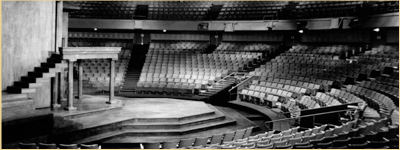Stratford Festival Theatre

A Good Block: The Stratford Festival Theatre
Click the following link to access the Image Gallery
This gallery follows the origins and evolution of the thrust stage from ancient amphitheatres to the Globe theatre of Shakespeare’s day, to the reinvention of the stage at the Stratford Festival in Canada. The thrust stage’s design by Tanya Moiseiwitsch, in which an actor can be seen from all sides, separated the Stratford Festival from other theatres worldwide, not only in terms of how a production was blocked, but also in the conception of how to perform, and how to design costumes, props, and sets. The thrust stage helped to foster a burgeoning Canadian theatre culture through the demands it made on both performers and different elements of design and production staff.
The Stratford Festival was founded in 1953 by Tom Patterson. One of its most distinctive features of the Festival was its reinvention and use of the thruststage. Dating back to the Greek and Roman Amphitheatres and the Globe Theatre, for which William Shakespeare was a partner, the thrust stage had fallen into disuse in favour of the proscenium stage. The Stratford thrust stage was designed by Tanya Moiseiwitsch and first appeared in the festival tent in the first season. Except for relatively small changes it remains relatively intact on the Festival stage today. Since its reinvention at Stratford, the thrust stage has been adopted around the world, including by the Royal Shakespeare Company in England.
The reason for the thrust stage’s renewed popularity lay in the flexibility and intensity of experience it provided for both the audience and the actors. This dynamic stage allows actors a much greater range of natural movement visible from much wider perspectives by the audience, a situation that makes performers rethink their use of space via their relationship to the audience as it sees them. Additionally; the audience sits around the stage, literally enclosing the actors, hence allowing for a more intimate setting than the proscenium stage. Due to the nature of the thrust stage and its improved visibility of all aspects of the production, costumes and props are enormously important, requiring more detail and specificity. The Stratford Festivals has a corps of highly skilled artisans that excel in wig making, shoemaking, leatherwork, metallurgy, costume decorating, and painting, as well as in making detailed and believable props, such as waxed fruit, robotronic monkeys, and royal, bejeweled crowns.
Click the following link to access the Image Gallery

